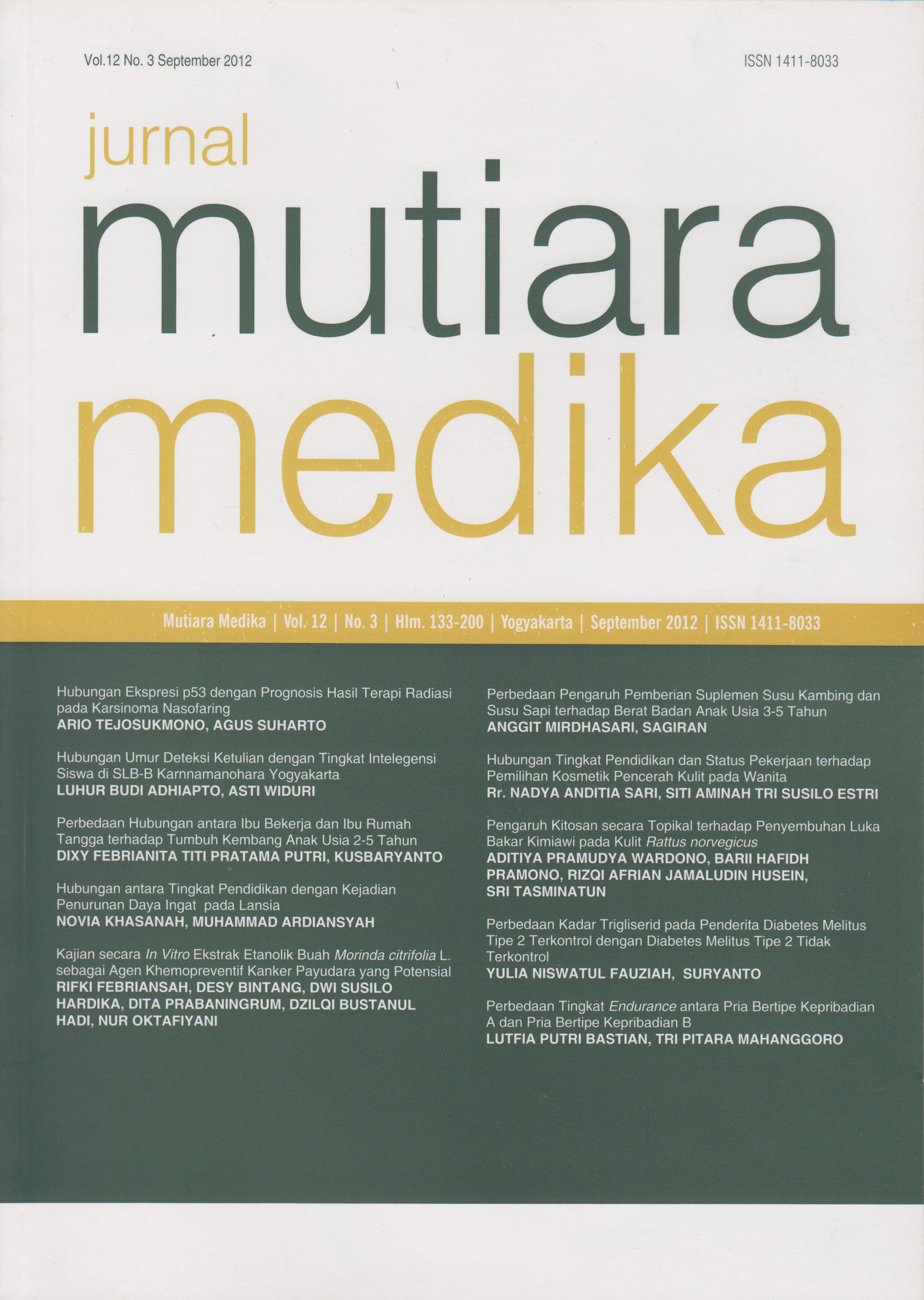Perbedaan Kadar Trigliserid pada Penderita Diabetes Melitus Tipe 2 Terkontrol dengan Diabetes Melitus Tipe 2 Tidak Terkontrol
DOI:
https://doi.org/10.18196/mmjkk.v12i3.1047Keywords:
diabetes melitus, trigliserida, aterosklerosis, dislipidemia, tryglicerida, atherosclerosisAbstract
Penyebab utama kematian pada diabetes melitus (DM) tipe 2 ialah penyakit jantung koroner (PJK) kurang lebih 80%. Angka kematian akibat PJK pada penderita DM tipe 2 dapat meningkat dua sampai empat kali lebih banyak dibandingkan dengan yang non-diabetes karena lesi aterosklerosis, pada penderita DM tipe 2 proses perkembangannya lebih cepat. Dengan adanya peningkatan kadar trigliserid (TG) dan Low Density Lipoprotein ( LDL) diketahui sebagai faktor risiko terjadinya aterosklerosis. Pemeriksaan HbA1c dapat digunakan sebagai pengendali untuk mengetahui risiko pencegahan komplikasi. Penelitian ini bertujuan untuk mengetahui adanya perbedaan kadar trigliserid pada penderita DM tipe 2 terkontrol dan tidak terkontrol. Desain penelitian observasional analitik dengan pendekatan cross sectional, sampel penelitian adalah pasien DM tipe 2 terkontrol (HbA1c <7%) dan DM tipe 2 tidak terkontrol (HbA1c >7%). Jumlah masing-masing sampel adalah 31 pasien. Analisis data menggunakan independent t-test. Hasil penelitian didapatkan rata-rata nilai trigliserid pada DM tipe 2 terkontrol 150,84+86 ,91 dan rata nilai trigliserid pada DM tipe 2 tidak terkontrol 153,55+64 ,193. Analisis menunjukkan bahwa tidak ada perbedaan yang bermakna kadar trigliserid pada penderita DM tipe 2 terkontrol dan DM tipe 2 tidak terkontrol secara statistik (p>0,05). Disimpulkan bahwa tidak ada perbedaan kadar trigliserid pada penderita DM terkontrol dan DM tidak terkontrol.
The most cause of mortality in type 2 diabetes mellitus (DM) is coronary heart disease (CHD) about 80%. Mortality rate caused by CHD in patients type 2 DM could increase two until four times more than non-diabetes cause atherosclerosis lesion, the development process faster in patients with type 2 DM. The increasing of tryglicerida (TG) and Low Density Lipoprotein (LDL) level know as atherosclerosis risk factor. HbA1c examination could use as controlling to know the prevention risk of complication. The purpose of this research is to know the difference of trigliserid level in patients with controlled and uncontrolled type 2 DM. The research design is analytic observational with cross sectional approach, the sampel are controlled type 2 DM (HbA1c <7%) and uncontrolled type 2 DM (HbA1c >7%). The number of each sampels are 31 patients. Data analyzed using independent t-test. The result shows value of trigliserid in controlled type 2 DM is 150,84+86 ,91 and means value of trigliserid in uncontrolled type 2 DM is 153,55+64,19. The result shows there is no significant difference level of trigliserid between patients with controlled and uncontrolled type 2 DM statisticly (p>0,05). It was concluded that there is no difference level of trigliserid between patients with controlled and uncontrolled type 2 DM.
References
American Diabetes Association. Standarts of Medical Care in Diabetes-2009. Diabetes Care, 2009; 32 (1): S13-S61.
Sherwood. Buku Ajar Fisisologi dari Sel ke Sistem. Jakarta :EGC. 2001.
Suyono, S. Patofisiologi Diabetes Mellitus, Penatalaksanaan Diabetes Mellitus Terpadu Ed. 5. Jakarta: FK UI. 2005.
S. Josten, Mutmainnah, Hardjoeno. Profil Lipid Penderita Diabetes Mellitus Tipe 2. Indonesia Journal of Clinical Pathology and Medical Laboratory, 2006; 13 (1): 20-22.
Ugwu, C.E., Ezeanyika, L.U.S., Daikwo, M.A. dan Amana, R. Lipid Profile of A Population of Diabetic Patients attending Nigerian national Petroleum Corporation Clinic, Abuja. African Journal of Biochemistry Research, 2009; 3 (3): 066-069.
Klinik Diabetes Nusantara. Kontrol HbA1c. 2007. Diakses tanggal 24 November 2009, dari www.klinikdiabetesnusantara.com.
Arief, I. Kadar HbA1c Mencerminkan Kadar Lipid. Pusat Jantung Nasional Harapan Kita. 2009. Diakses tanggal 13 Maret 2010, dari http://www.pjnhk.go.id/index.php?option=com _content&task=view&id=2181&Itemid=32.
Perkumpulan Endokrinologi Indonesia. Pengelolaan Diabetes Mellitus tipe 2, Konsensus Pengelolaan dan Pencegahan DM Tipe 2 di Indonesia. Jakarta: PERKENI. 2006.
Alfarisi, S., Basuki, W., Susantiningsih, T. Perbedaan Kadar Kreatinin Serum Pasien Diabetes Melitus Tipe 2 yang Terkontrol dengan yang Tidak Terkontrol di Rsud Dr. H. Abdul Moeloek Bandar Lampung Tahun 2012. MAJORITY (Medical Journal of Lampung University). Vol 2, No 5 (2013): 129-136
Adam, JMF. Dislipidemia, Buku Ajar Ilmu Penyakit Dalam, Ed.4 Vol.3. p. 1926-1931. Jakarta: FK UI. 2006.
Schteingart, DE. Pankreas: Metabolisme Glukosa dan Diabetes Melitus. Patofisiologi Konsep Klinis Proses-Proses Penyakit (Ed.6). Jakarta: EGC. 2006.
Beckman, J.A., Creager, M.A., Libby, P. Diabetes and Atherosclerosis. JAMA. 2002 ; 287 (19): 2570-2581.
Olefsky, J.M. Prospects for Research in Diabetes Mellitus. JAMA. 2001 ; 285, 628-632.
Dorland, N. Kamus Kedokteran Dorland. Jakarta: EGC. 2002.
Mayes, P.A., Murray, R.K., Granner, D.K., Rodwell, V.W. Biokimia Herper (25th ed). Jakarta: EGC. 2003.
Kendall, D.M. The Dislipydemia of Diabetic mellitus: giving triglycerides and high-density lipoprotein cholesterol higher priority?. Endocrinol Metab Clin North Am. 2005; 34 (1): 27-48.
Guyton, A.C., & Hall, J.E. Buku Ajar Fisiologi Kedokteran ed. 9. Jakarta: EGC. 1997.
Fowler, MJ. Microvascular and Macrovascular Complications of Diabetes. Clinical Diabetes. 2008 ; 6 (2): 77-82.
Anonim, Hipertrigliseridemia: Peningkatan Risiko Lemak Hati dan Pankreas. Reduce Triglyceridemia.com. 2004. diakses dari http:/ /www.reducetriglycerides.com/pancreatitis template.htm pada tanggal 18 Mei 2010,
Ian, S.G., L Edwards, A., Symonds, C.J., and Beck, L.P. Hypertriglyceridemia –Induce Pancreatitis: A Case-Based. World Journal of Gastroenterology, 2006; 12 (44): 7197-7202.
Downloads
Published
Issue
Section
License
Copyright
Authors retain copyright and grant Mutiara Medika: Jurnal Kedokteran dan Kesehatan (MMJKK) the right of first publication with the work simultaneously licensed under an Attribution 4.0 International (CC BY 4.0) that allows others to remix, adapt and build upon the work with an acknowledgment of the work's authorship and of the initial publication in Mutiara Medika: Jurnal Kedokteran dan Kesehatan (MMJKK).
Authors are permitted to copy and redistribute the journal's published version of the work (e.g., post it to an institutional repository or publish it in a book), with an acknowledgment of its initial publication in Mutiara Medika: Jurnal Kedokteran dan Kesehatan (MMJKK).
License
Articles published in the Mutiara Medika: Jurnal Kedokteran dan Kesehatan (MMJKK) are licensed under an Attribution 4.0 International (CC BY 4.0) license. You are free to:
- Share — copy and redistribute the material in any medium or format.
- Adapt — remix, transform, and build upon the material for any purpose, even commercially.
This license is acceptable for Free Cultural Works. The licensor cannot revoke these freedoms as long as you follow the license terms. Under the following terms:
Attribution — You must give appropriate credit, provide a link to the license, and indicate if changes were made. You may do so in any reasonable manner, but not in any way that suggests the licensor endorses you or your use.
- No additional restrictions — You may not apply legal terms or technological measures that legally restrict others from doing anything the license permits.






